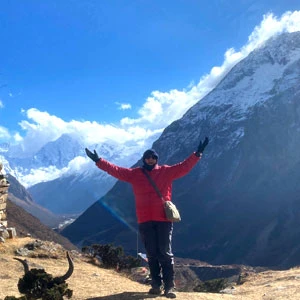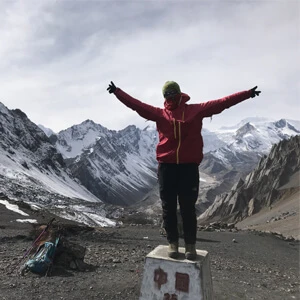Mohare Danda Trek Overview
The Mohare Danda Trek, also called the Myagdi Community Eco Trek or Annapurna Dhaulagiri Eco Trek, is one of Nepal’s best-kept secrets. Tucked between the Annapurna and Dhaulagiri mountain ranges inside the Annapurna Conservation Area, this route was designed by locals to promote eco-friendly and community-based tourism. It is a quieter, more soulful alternative to the busy Ghorepani Poon Hill Trek, yet provides mountain scenery to equal if not better than its southerly neighbor.
This trekking route provides just about everything you would expect from a trekking experience in the Himalayas, such as magnificent peaks, an abundance of pristine nature, and the friendliest mountain people you are ever likely to meet. You will be surrounded by the magnificent peaks of Machhapuchhre (Fish Tail), Annapurna South, Annapurna I, Dhaulagiri, Nilgiri, and so on.
Your journey starts with a drive from Kathmandu to Pokhara, then to Beni, where the trail officially kicks off. From there, you will wander through Banskharka village, which is known for its orange orchards and terraced gardens. Following it, you will explore Nangi village, where you will get to interact with locals involved in innovative projects like handmade paper or community schools. Then, finally, you will climb up to Mohare Danda. At 3,300 meters, you will witness mesmerizing sunrises and sunsets with panoramic views of Annapurna, Dhaulagiri, and Machapuchhre.
From here, you will then descend into Swanta village through pine forests and terraced farmlands before tackling the climb up to Khopra Danda, another ridge with breathtaking 360° mountain views. If you have got the energy, you can even take a side trip to Khayar Lake (4,665 meters), which is a sacred alpine lake. On the way back, you will pass through villages such as Dobato, Tadapani, and Ghandruk, each offering its own mix of Magar and Gurung hospitality, stone houses, and homestays.
During this adventure, you will stay in community-run eco lodges, eat local food, and directly support the villages that built and maintain this trail. Depending on the time you are trekking, you will also have a chance to encounter several festivals. If you are trekking in mid-January, you will witness the Maghe Sankranti celebration in Magar villages. Similarly, in mid-October and November, you will enjoy Nepal's biggest festivals, Dashain and Tihar. Lastly, if you are in Ghandruk village in late January, you will get to enjoy the Tamu Lhosar (Gurung's New Year).
Altogether, Mohare Hill Trek is a family-friendly, beginner-friendly, and super budget-friendly expedition that is packed with authentic culture, lush forests, terraced hills, and traditional festivals. You stay in community-run eco-lodges, eat meals cooked from local produce, and know your presence directly helps preserve culture and environment.
If you are searching for an offbeat, eco-conscious trekking experience in Nepal, where the mountains are as breathtaking as the culture is welcoming, the Mohare Danda Community Trek is exactly where you should go.
Why Choose Mohare Danda Trek In Nepal?
Mohare Danda Viewpoint
The Mohare Danda Viewpoint is situated at an elevation of about 3,300 meters, tucked between Ghorepani and Galeshwor in the Annapurna region of Nepal. It is a quieter and more soulful cousin of Poon Hill with the same jaw-dropping views. What makes it special is that it’s a community-managed eco-trail, built and maintained by locals who wanted to create a sustainable trekking route. Therefore, you will be walking a trail that directly supports the people who call these mountains home.
The climb itself is a moderate one, which is perfect for beginners, families, or even seniors who just want a taste of the Himalayas without pushing to extremes. You will pass through stone steps, gentle ascents, and dreamy forest walks filled with oak and pine forests. Now, if you are trekking in Spring, you will find the whole hillsides of rhododendrons exploding in pink and red. Along the way, you will also come across terraced farmlands and cascading waterfalls.
Standing on top of the Mohare Danda ridge, you will find a panoramic Himalayan masterpiece: Annapurna I (8,091 meters), Dhaulagiri (8,167 meters), Machhapuchhre (Fishtail), Nilgiri, Hiunchuli, Gangapurna, and Tukuche Peak. At sunrise and sunset, the peaks turn gold, pink, and fiery orange, making it one of the best spots in Nepal for mountain photography.
Unlike Poon Hill, where you are jostling for a good photo, here at Mohare Danda, you can actually hear the wind, the birds, and your own heartbeat. It’s a place that gives you space to just breathe and take it all in.
Side Hike to Khopra Danda
If you have made it to Mohare Danda, the natural next step for adventure is the side hike to Khopra Danda (Khopra Ridge) at an elevation of 3,660 meters in the Annapurna region of Nepal. The trail from Swanta village to Khopra Danda takes about five hours, and while it’s more demanding, steeper, narrower, and wilder than the Mohare route, it rewards you with views that honestly feel like a cheat code to the Himalayas.
As you climb the ridge, you will weave through rhododendron, oak, and pine forests. If you are lucky, you might catch a Himalayan thar, colorful Danphe (Nepal’s national bird), or even yaks. The real payoff, though, is at the ridge itself. From Khopra Danda, you stand face-to-face with Dhaulagiri (8,167 meters), Annapurna I, Machhapuchhre (Fishtail), Nilgiri, Tukuche Peak, and even Lamjung Himal.
Additionally, you will also see the deep Kali Gandaki Gorge below. If you are here at sunrise, you will see the peaks blaze in gold as light crawls slowly across their jagged faces. Now, if you are here at sunset, the valleys below sink into mist and shadow while the ridgelines glow in soft pink and amber. Few viewpoints in Nepal give you this kind of 360° theater of light. All in all, Khopra Danda hike is one of the most underrated gems in the Annapurna region.
Side Trip to Khayar Lake
During the Mohare Danda Trek in Nepal, you can choose the side trip to Khayar Lake (4,600 meters). This alpine lake is cradled in a glacial basin right beneath the towering face of Annapurna South. Here, you will also see its waters mirroring the peaks. Also, this lake is sacred for both Hindus and Buddhists. Once here, you will find a small shrine and the Khair Barah temple at its shore, where locals and pilgrims gather during Janai Purnima (usually in August) to perform rituals, offer sacrifices, and seek blessings.
The trek from Khopra Ridge to Khayar Lake is a long and demanding day, which is often a 9-to-10-hour round trip, tracing yak herding trails and cutting across high alpine meadows. The path here is steep, barren, raw, and opens up to windswept ridges. From this lake, you will get the entire view of the Annapurna and Dhaulagiri ranges stretching across the horizon, with Machhapuchhre, Nilgiri, and Tukuche Peak over the deep Kali Gandaki Gorge.
Hike to Muldai Viewpoint
Situated higher than both Poon Hill (3,210 meters) and Mohare Danda (3,300 meters), Muldai offers an unmatched 360° Himalayan panorama that stretches from Annapurna I and Dhaulagiri to the elegant Machhapuchhre (Fishtail), all the way across to Lamjung Himal, Hiunchuli, Nilgiri, and even Manaslu and Ganesh Himal on crystal-clear days. Well, it might just be the best viewpoint in the Annapurna region of Nepal.
The Muldai hike itself feels like a hidden detour from Khopra Ridge, passing through dense rhododendron forest, pine groves, and open alpine meadows. The trail here is easy to moderate, with just enough steep stretches to get your heart pumping but never enough to overwhelm. By the time you are pushing through the final ascent to Muldai, you will find solitude, silence, and a mountain panorama that seems too wide for your eyes to take in all at once.
At the top of the viewpoint, you will also find prayer flags fluttering in the wind. Sunrise from Muldai Viewpoint is surreal with gold spilling over snow giants, valleys still wrapped in shadow, and cloud layers drifting like seas below.
Explore the Famous Ghandruk Village
Perched on the western slopes of the Annapurna range, Ghandruk is a traditional Gurung village in Gandaki Province that has long been a favorite stop for trekkers. From almost every corner of the village, you will catch jaw-dropping views of Annapurna South, Machhapuchhre (Fishtail), Hiunchuli, Gangapurna, and Annapurna III.
Here, Ghandruk is a living museum. The stone-paved alleys wind past traditional Gurung houses with carved wooden windows, surrounded by terraced fields of rice, millet, maize, and even small tea gardens. The village has a proud history too; many of its men once served as legendary Gurkha soldiers. Today, the Gurung Museum gives visitors a closer look at that heritage, from weapons and uniforms to everyday tools and cultural artifacts.
What really sets Ghandruk apart, though, is its vibrant culture. You will often see locals in traditional Gurung attire: men in kachhad, bhoto, and the iconic black vaadgaule topi, and women in velveteen blouses (ghalek), dark red lungi, and ornaments like nugedi and jantar. If you are lucky, you might stumble upon a Rodhi gathering, which is a traditional community night of music, singing, and dancing.
Moving on, the locals here follow Buddhism, and festivals are woven into daily rhythms. The most vibrant celebration of all is the Tamu Lhosar, the Gurung New Year, which is celebrated in late December or early January. During this event, the village comes alive with cultural shows, dancing, feasts, and rituals. Now, while you are in this village, you should take a walk through Seuli Bazaar.
Experience Community Eco-Lodge Trek
One of the most unique aspects of the Mohare Danda Trek is its fully community-driven eco-lodge model, a first in Nepal. Unlike most trekking routes where private lodges dominate, here every accommodation is owned and operated by local communities, ensuring that your trekking dollars directly benefit the people who live along the trail. The communities of Nangi, Banskharka, and nearby villages manage everything, from trail maintenance to dining facilities. so you can enjoy a well-kept route while knowing your stay supports sustainable development.
About 90% of the revenue they collect goes straight back into the local community, funding education, infrastructure, and small businesses, while only a fraction covers administrative costs. This model makes trek sustainable tourism. Along the way, you will find eco-lodges with cozy rooms, modest shared bathrooms, and simple dining. You will get to experience the organic meals cooked with ingredients from village farms.
The trail itself is peaceful and less crowded, which offers a serene escape for families, first-time trekkers, and anyone seeking cultural depth. As you move from lodge to lodge, you can engage directly with villagers, witness a paper-making workshop, visit local schools, explore organic farms, or watch traditional weaving.
Witness Ethnic Magar Communities
As you trek along the Mohare Danda route, one of the highlights is encountering the Magar communities, among Nepal’s largest and most historically rich indigenous groups. Nestled in the western hill regions of Gandaki and Myagdi, these villages, like Nangi, are alive with tradition and daily mountain life. The Magars are of Tibeto-Burman origin and maintain strong cultural ties to Tibet and Myanmar, which is reflected in their language, attire, and customs.
Walking through the villages, you will notice two-storey stone houses with slate or thatch roofs, wide verandas, and intricate wooden detailing. The locals here sustain themselves through agriculture, livestock herding, weaving, and basketry, while many serve proudly in the Gurkha regiments. Your Mohare trek directly supports their livelihoods, as community-run eco-lodges and homestays provide a sustainable source of income and foster authentic cultural exchange.
Moving on, the Magars’ cultural fabric is a vibrant mix of shamanistic nature, with Hinduism, and Buddhism. Depending on when you trek, you might witness traditional Magar festivals. In mid-January, the Magar community celebrates the Maghe Sankranti, which marks the winter solstice and is a time for cleansing rituals, feasting, and community gatherings. Locals prepare traditional foods like dhido, gundruk, and batuk, and offer prayers to ensure prosperity for the year ahead.
Another unique celebration is Bhume Puja, honoring the Earth deity, where villagers perform rituals and dances to bless the land and livestock. Even during national festivals like Dashain and Tihar in mid-October, the villages light up with colorful decorations, sacred rituals, and family feasts.
During these festivals, the local community performs folk dances. One of the major dances is Maruni, which is performed by women in colorful attire, moving gracefully to drum beats. Additionally, dances such as Hurra and Sorathi involve storytelling through song and dance, often narrating heroic tales or community legends, and Bhume Nach is a ritualistic dance performed to honor the Earth and local deities.
Enjoy Panoramic Himalayas, Nature, & Wildlife
Starting from Pokhara and winding through Beni, the Mohare Hill Trek immediately immerses you in Nepal’s terraced farmlands, orchards, and lush village pathways, giving a warm, authentic Himalayan welcome. Along the trail, the scenery gradually shifts into forests of rhododendron, oak, pine, bamboo, and thur (fern-like bamboo), which is especially breathtaking if you are trekking in Spring, as the rhododendrons (the national flower of Nepal) explode in shades of red, pink, and white. Similarly, you will also spot lokta plants on the trail, which are generally used for handmade paper.
From high vantage points like Mohare Danda, the Himalayas unfold in a 360° panorama: peaks, like Dhaulagiri (8,167 meters), Annapurna I (8,091 meters), Annapurna South (7,219 meters), Machhapuchhre / Fishtail (6,993 meters), Nilgiri (7,061 meters), and Tukuche Peak (6,920 meters) dominate the horizon, and on clear days, Manaslu even makes a cameo. Sunrise and sunset from these viewpoints are especially magical, as golden light bathes the ridges and valleys.
During this trek, you might spot wildlife such as Himalayan Tahr, musk deer, langur monkeys, and yaks or buffalo grazing in high pastures. As for birdwatchers, you will also get glimpses of the Impeyan Pheasant (Danphe), Nepal’s national bird, along with other pheasants, flycatchers, and Himalayan avifauna.


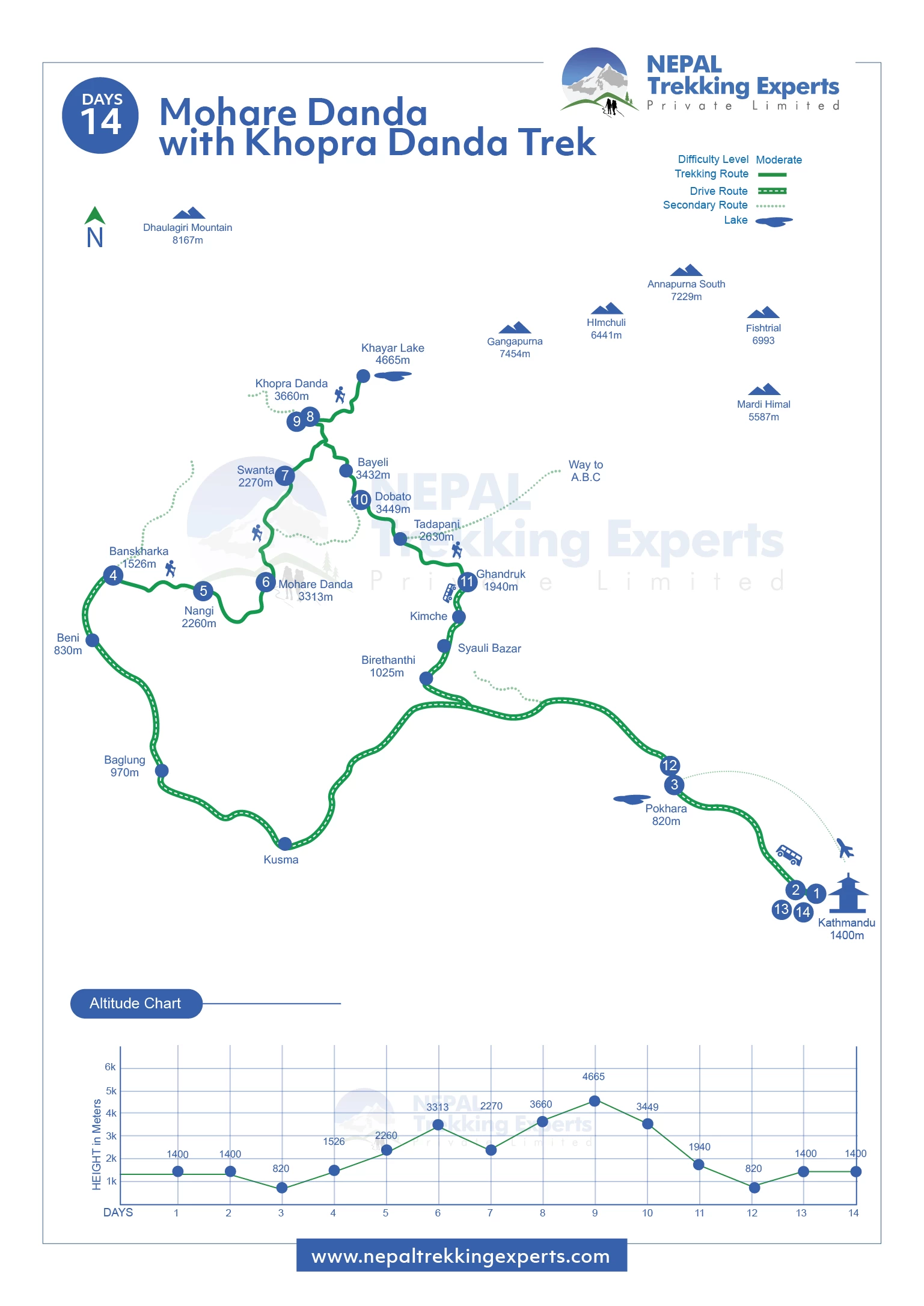

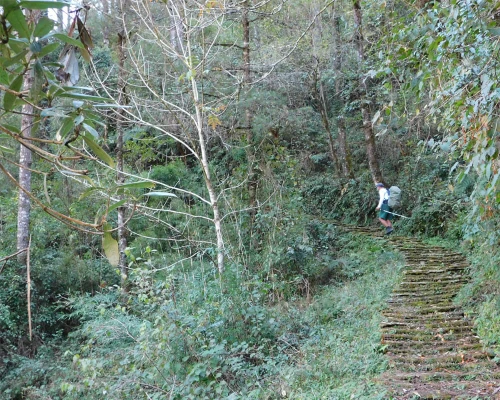
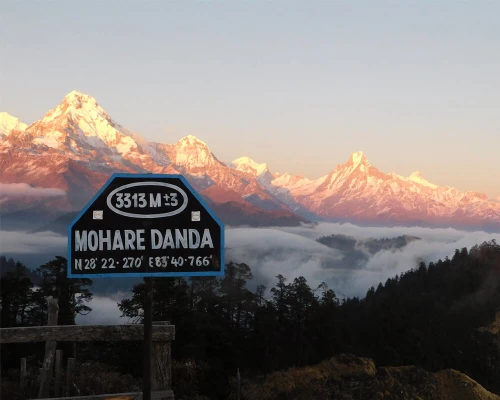


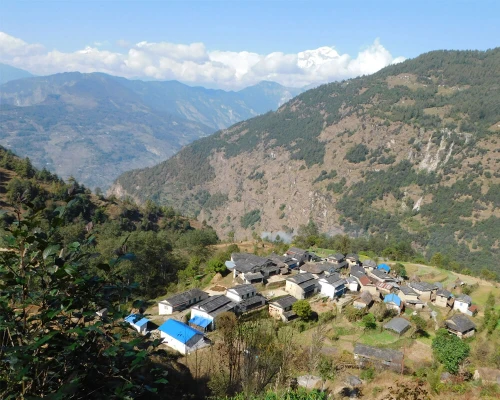


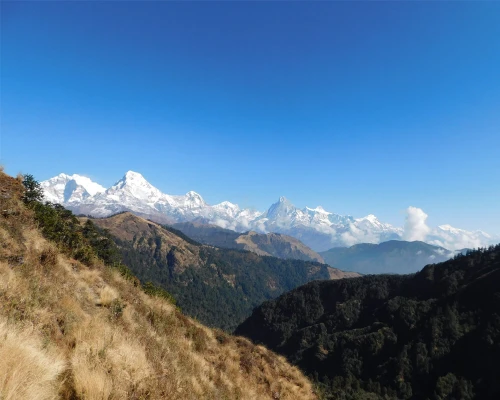


 based on 5 reviews
based on 5 reviews



